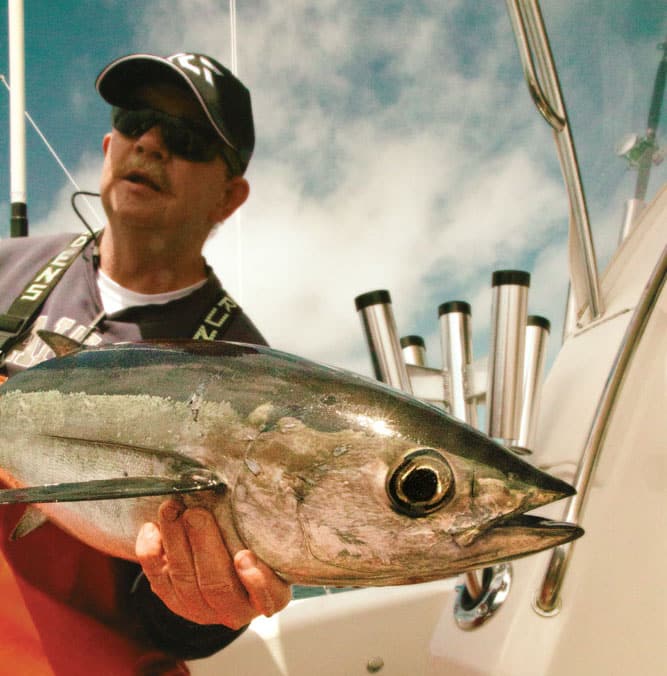
Ilwaco, Washington, sits about as far from everything as you can get at the southwestern tip of Washington state. Yet this small fishing village lies as close as you can get to the mouth of the Columbia River, tucked into the lee of Cape Disappointment. That landmark’s moniker might reflect the sentiments of Lewis and Clark when they ended their epic journey here in 1805, but it hardly reflects the productive fishing that awaits every summer when albacore tuna appear offshore on their annual migratory loop around the North Pacific.Acres of Tuna
Albacore tuna, sometimes referred to as longfin tuna, represent a major forage, commercial and sport fish, in the Pacific. These fish are prolific — perhaps even more so than dolphin.They maintain healthy populations, and when they appear nearshore, anglers count their catch by the dozens, and the size of the offshore schools in acres.
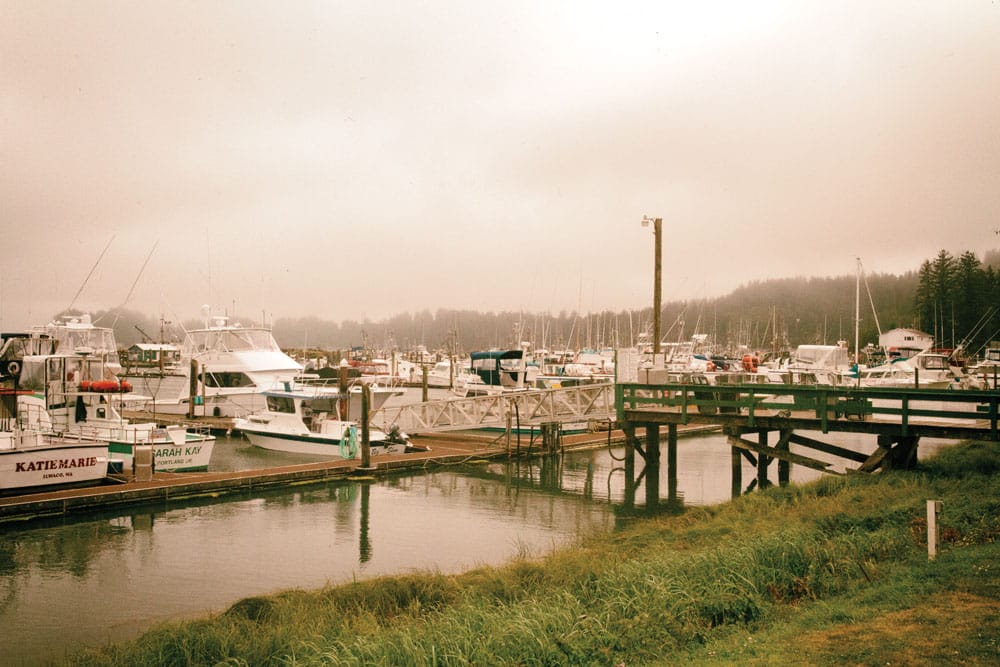
I traveled to Ilwaco to rendezvous with these fish during the first leg of the Oregon Tuna Classic, an annual two-tournament series — one out of Ilwaco, on the Washington side of the Columbia, and the second out of Garibaldi, Oregon. After a three-hour drive from Portland, I met up with the Bad to the Bone fishing team, headed by Del Stephens, a 25-year albacore veteran and acknowledged expert, to fish the one-day tournament aboard Stephen Seal’s 56-foot Riviera Booyaa.
Morning found us heading out the mouth of the river, over the infamous Columbia River Bar. This 3-mile-wide-by-6-mile-long stretch of river-meets-ocean is one of the most treacherous river mouths in the world. The flat-water transit that morning offered little in the way of excitement, yet everyone routinely buckles on life jackets until safely over the bar. This inlet goes from sedate to lethal in a matter of minutes with a switch of the wind. The OTC schedules for days with incoming tides morning and afternoon, so tournament boats time their crossing to coincide with the flood, the only reasonable time to be on a boat where the 4- to 7-knot river current meets the Pacific swells running onto the shifting shoals at the river mouth. Paying attention to the periodic Coast Guard Bar Report, they’ll scrub the day’s fishing when waves on the bar top 12 feet.
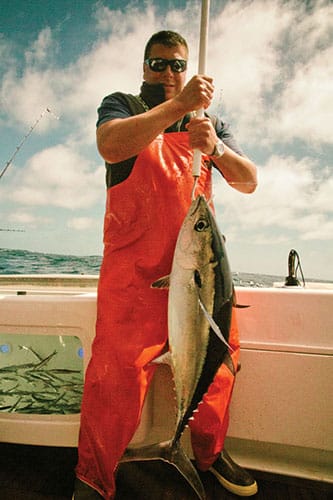
Play the Spread
Once into the open Pacific we headed southwest, and soon Stephens, mate Anthony Warren, and anglers Meagan Waltosz and Weddy Stephens slipped into their bibs, deployed the trolling spread, and took up their well-practiced stations in the cockpit.
Strategy on early and midsummer fish, Stephens explained, hinges on trolling to locate the bait and the albacore. A typical setup employs Archer Spreader Bars on the long riggers with a Zuker Zucchini Broomtail trailing, Eat Me Lures Mexican Flags inside on the short riggers, and pink-and-white Ballyhood Albacore Allstars on the flat lines off the transom corners.
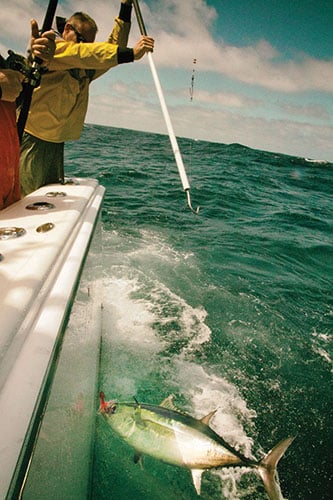
Canyon Run
Astoria Canyon is the key to finding the bait and the fish. This 75-mile-long crack in the Continental Shelf heads up in just over 350 feet of water, 11 miles south of the Columbia Bar, and runs west, dropping into the abyss with a relief of 3,000 feet. This complex underwater topography draws the bait, and the schools of 15- to 30-pound albacore that follow.
Once we arrived in the vicinity of the canyon, we had customers. With a fish peeling line off a long rigger rod, Seal backed straight down toward the fish, leaving the lures in the water to sink for fish holding deep, while the crew chummed off the back with anchovies. Once the lures had time to sink, Stephens dropped a flutter jig, the “iron” as they call it here, looking to pick up fish holding at 20 to 100 feet down, and the rest of the crew retrieved the trolling lures, rigged live anchovies, and free-lined them to drift with the current. And the tuna started picking them off, one by one.
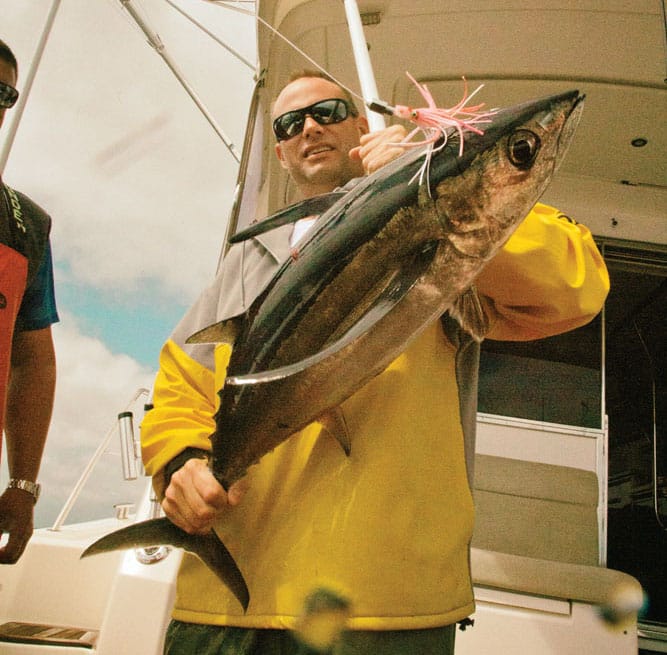
Tuned Team
The well-practiced crew moved in concert, fighting fish, moving around the cockpit, gaffing them boat-side, and depositing them in the bleed barrel fastened to the transom platform. With half a dozen tuna in the barrel, the bite tapered off.
“I was hoping for a conversion to a wide-open bite,” Stephens explained. The conversion is key to putting a lot of fish in the boat in short order. Creating a feeding frenzy in the school, a wide-open bite typically allows the team to boat from 30 to 60 fish before it dissipates. It’s the key to winning numbers in a tournament, or simply a great day otherwise.
Once the school moved off and the anchovies drifted unmolested, we went back on the troll, looking to repeat the action. Tuna in the barrel went onto ice, the crew hosed each other down (albacore fishing can be a bloody business), and we set out the spread again to find more fish.
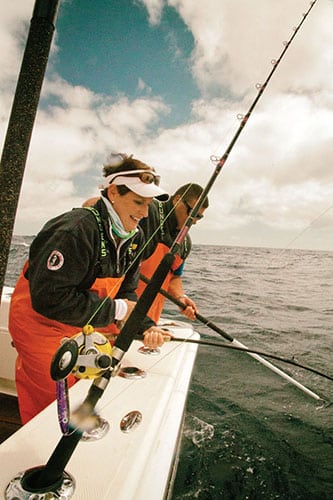
Summer Strategy
Early in the season, trolling is the most effective way to connect with the newly arrived albacore schools. Later in the year — and the fish hang around usually through mid-October — they get more selective and more skittish, Stephens explains, and he moves on to late-season tactics. He swaps out the skirted trolling lures for lead-headed plastic swimbaits, trolled at 3 knots about 125 feet back. Or as an alternative strategy, he “runs and guns,” looking for jumping fish or birds. With late-season fish, it’s critical to slide the boat in next to the school, shut down, chum lightly, and cast into the school while working the iron deep.
At times like this, when relying on light chum and jigging to convert the wary schools to a wide-open bite, the team often opts to fish from Stephens’ 33-foot center-console Hydra Sport, Tuna Dog. With lower freeboard and no upper structure to catch the wind, the smaller boat drifts slower. Even a light breeze can push a larger boat fast enough to make vertical jigging more difficult and a lot less effective.
Over a couple of days of fishing, we averaged a few dozen fish a day — not as fast and frantic as Team Bad to the Bone had hoped, but for this East Coast-based angler, that’s a lot of tuna action.
Abundant Albacore
Summer school albacore run up to 30 pounds. A big fish is 35 pounds. The fish in this size class, three- to four-year-olds, have not yet reached spawning age. Grown adults can reach 80 pounds. The voracious school-size albacore, lacking swim bladders, must be constantly on the move, and to fuel their high metabolisms, reportedly consume up to 25 percent of their own weight every day in squid, midwater shrimp, saury, blue lanternfish, and anchovies. The schools show up off Oregon and Washington in mid-June; Fourth of July is the customary season kickoff, and some years they’ll remain until Halloween.
About the OTC
The all-volunteer nonprofit Oregon Tuna Classic donates all fish caught to the Oregon Food Bank. Celebrating its 10th year in 2014, the OTC has donated more than a million pounds of albacore to the cause.
This year the Oregon Tuna Classic divided into the Deep Canyon Challenge in Ilwaco, Washington, on Aug. 1 and 2, and the Oregon Tuna Classic on Aug. 22 and 23 in Garibaldi, Oregon. Each event draws up to 900 participants from nearby states. For more information, go to oregontunaclassic.org.









